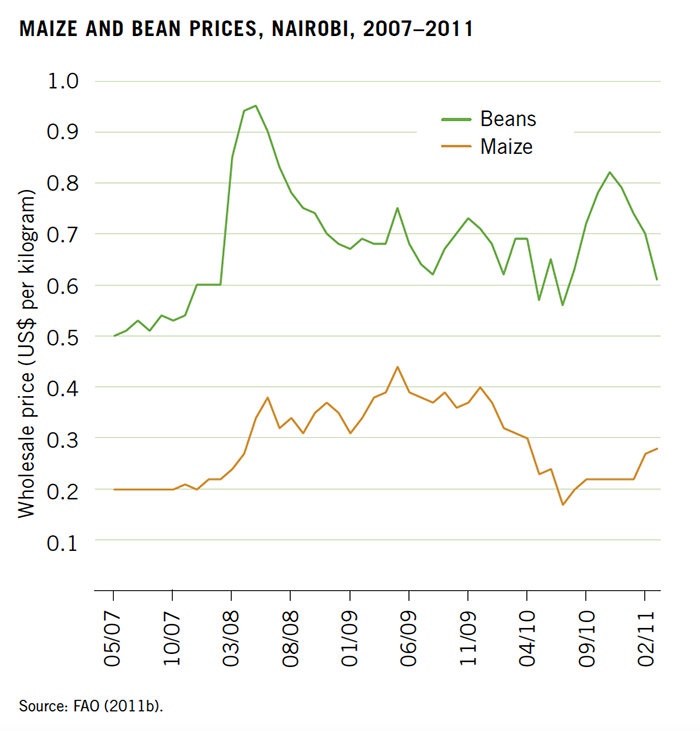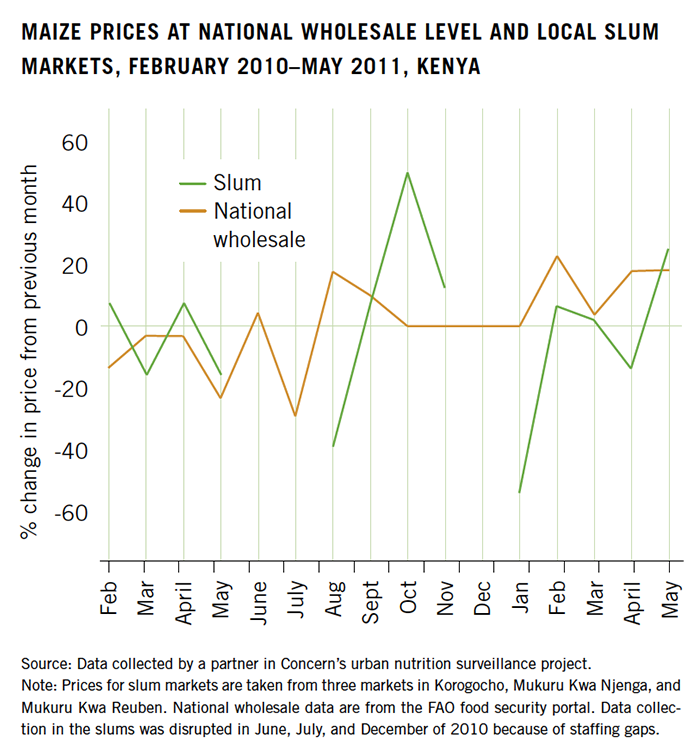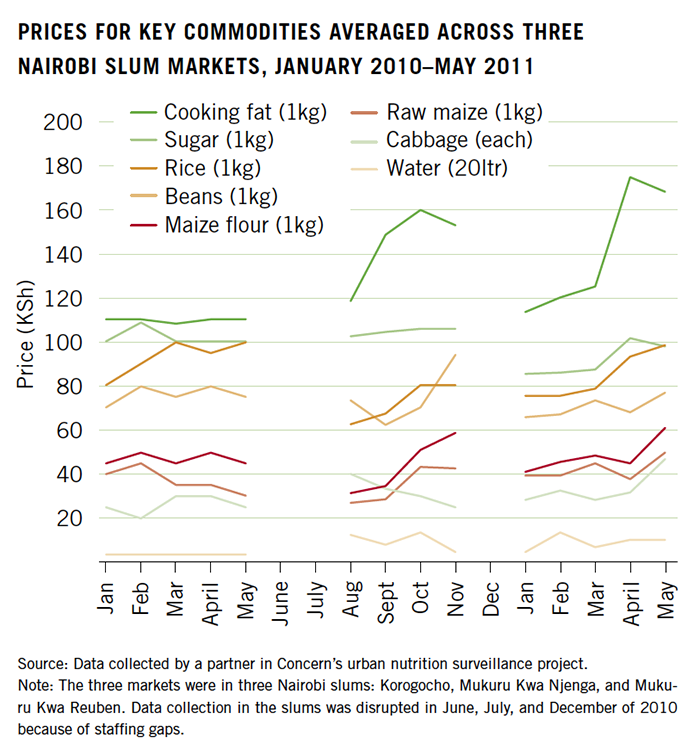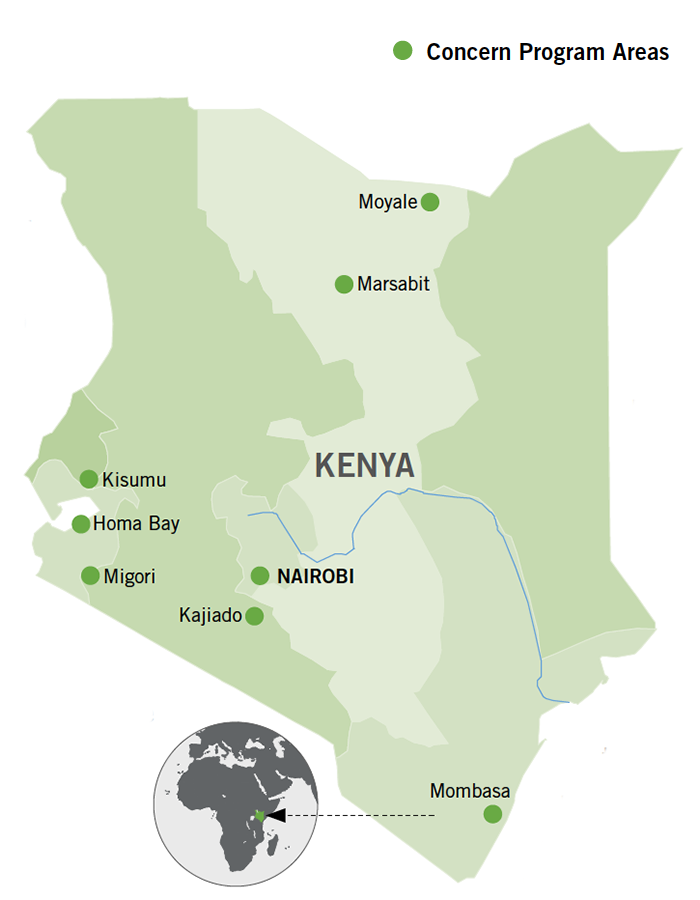How Food Price Spikes and Volatility Affect the Urban Poor:
Evidence from Nairobi, Kenya
Nonfarm income opportunities and livelihood options, as well as pro-poor agricultural growth, need to be supported and improved.
Note: This case study by Concern Worldwide reflects the views of this organization. It is intended not to present research findings, but rather to show examples from their practical work and experiences in the field.



Despite significant economic growth in the past decade, hunger remains a painful daily reality for millions of Kenyans. Ranked 50th out of 81 countries in the 2011 GHI, Kenya was – even before the most recent food crisis hit the region – classified as having a serious hunger problem. Between January and May 2011 in Nairobi, admissions to hospitals and community centers for treatment of severe acute malnutrition in young children increased by 62 percent.
At the time of writing, the crisis in the wider region is putting even greater pressure on national health systems and services, with famine declared in regions of neighboring Somalia and thousands of refugees flowing into the country daily. Kenya is not on track to meet the Millennium Development Goal related to undernutrition, and the food crisis in the wider Horn of Africa will exert further pressure on any progress toward this goal.
Like many other countries in Sub-Saharan Africa, Kenya has seen significant increases in food prices since 2007. The drivers of these increases are both internal and external. The violence that spread across Kenya following the disputed presidential election in 2007 caused crop destruction, abandonment of farms, and destruction of stores that led to a 30 percent reduction in national food production (Höffler and Owuor Ochieng 2009). Droughts in 2008 and 2011 took a toll on food production in the central and western regions and severely reduced food security, particularly in arid and semiarid pastoralist areas. Kenya is also highly dependent on imports, even in years of good harvest. It is therefore especially sensitive to increases and volatility in international food and fuel prices.
National Price Trends. The consumer price index, a composite measure of the prices of 15 different goods indexes, has increased by 30 percent in the past three years (KNBS 2011). This overall increase has been accompanied by substantial price fluctuations and volatility over time. The whole-sale prices of two key commodities, white maize and beans, show these fluctuations clearly (see figure). Even more dramatic are the changes in month-to-month prices (see figure). Between February 2010 and May 2011, month-to-month price changes ranged from 0 to 29 percent for maize, and from 0 to 42 percent for beans (not shown in figure).
Transmission of volatility to local levels. As Kenya’s largest urban center, Nairobi is home to more than 3 million people, 60 percent of whom live in informal settlements scattered throughout the city. Urban populations are highly dependent on markets for basic needs including food, shelter, water, and cooking and heating fuel. The urban poor generally buy goods on a day-to-day basis. For this reason, they can end up paying higher per-unit prices than their wealthier urban counterparts.
To better understand the extent to which price volatility at the national level is passed on to the local level, monthly price data on staple foods and key nonfood items were collected in three slums in Nairobi (Korogocho, Mukuru Kwa Njenga, and Mukuru Kwa Reuben). Prices varied significantly between markets, and when prices were averaged across the three markets (see figure), the data show that from January 2010 to May 2011 slum dwellers faced high levels of price fluctuation across time. Comparing month-to-month price changes at national and local levels, it is clear that significant volatility exists at both national and local levels and that local prices can fluctuate substantially even at times of stable national prices (see figure).
Local factors also contribute to volatility. Between November 2010 and January 2011, while prices at the national level remained stable, price changes in slum markets oscillated between 10 and 50 percent. Local factors contributing to this volatility include increased insecurity around the holiday period and greater demand as urban dwellers purchased larger quantities of goods and then traveled upcountry for the festivities.
In addition to fluctuations over time, prices in local markets also vary spatially. In May 2011, the price of 1 kilogram of maize flour ranged from 44 to 46 Kenyan shillings (KSh) – which is about US$0.49 to $0.52 – across four markets within Viwandani, a slum in Nairobi’s industrial area that covers less than 1 square kilometer. Although 2KSh (US$0.02) may not seem like a significant fluctuation, for households that spend between 40 and 60 percent of their household income on food, even such minor fluctuations have major impacts on household consumption and well-being.
Part of this spatial variation seems to be linked to location and convenience: markets with shops located in the interior of the slum charge higher prices than those along main roads and in the main open-air markets. The supplier used and quantity purchased also affect price variation; some traders are able to buy in larger quantities from wholesalers, and others can buy only smaller amounts at higher unit prices. Supplier location affects transport costs too, which are in turn passed on to the consumer.
Average daily wages in this area are 178KSh (US$1.99). This income must cover food, water, rent, toilets (which are paid for daily on a per-use basis), transport, school fees, and all other basic needs. As Teresia’s story demonstrates (below), slum dwellers expend significant effort in seeking the cheapest prices each day in order to make the most of their food budgets.
When household budgets do not meet household needs, it is often food intake that suffers because food consumption is a more flexible expenditure than rent, school fees, and transport. Households will reduce quantity, quality, and variety of foods to make up for shortfalls in the household budget. The effects of such coping mechanisms can be devastating and lead to increasing numbers of children suffering from severe acute malnutrition. The work of Concern and its partners has begun to address these effects.
Concern’s responses: Cash transfers, livelihood development, and urban nutrition.

The urban poor face many barriers to improving their livelihoods, health, and food security. High price volatility is just one. To help extremely vulnerable households build their resilience and plan for the future, price volatility must be not only mitigated and dampened at the national and regional levels but also addressed at the local level.
Concern’s urban nutrition program (launched in 2007) and its urban livelihoods and social protection program (launched in response to the post-election violence and the food price crisis of 2007–08) seek to address the acute needs of thousands of people like Teresia, who live in the slums of Kenya and whose lives are further threatened by pervasive and ongoing price volatility.
In November 2009, as part of its urban livelihoods and social protection program, Concern launched a cash transfer pilot program, the aim of which was to protect the food security and well-being of extremely poor and vulnerable people living in the Korogocho slum and to test modalities for a broader national social protection scheme. The initial evaluation shows that participating households were able to significantly improve their food security and dietary diversity and reduce negative coping strategies. The average number of meals per day increased from 1.6 at the beginning of the program to 2.5 at the endline in October 2010.
Over the same period, the proportion of households classified as severely food insecure dropped from 97.4 percent to 73.7 percent. The use of negative coping strategies also fell significantly. The practice of trading sex for money or food declined from 21.9 to 9 percent, and engagement in child labor dropped from 38.5 to 12.2 percent. It is hoped that these improvements can be enhanced through ongoing and more innovative work to help poor urban households break the cycle of poverty, food insecurity, and vulnerability. The possibility of a national social protection scheme is still under discussion with the government and other stakeholders.
To help poor families build more resilient livelihoods, Concern has also introduced a livelihood development approach. Between late 2009 and May 2011, 700 households in Korogocho, Nairobi, and 300 in Nyalenda, Kisumu (a city in western Kenya), received skills training while 1,461 individuals received small business grants to start a new business or invest in an existing business. Market analysis in both slums had previously identified sectors and areas offering employment and business opportunities. Through local partners, Concern also facilitates links to other services, including health, microfinance, and home-based care.
Finally, Concern implements an urban nutrition program. It works with nine partners, including the Government of Kenya, to mitigate the impacts of poor household food security on young children and to improve feeding and care during the critical thousand days between conception and a child’s second birthday. Since its inception in 2007, the urban nutrition program has treated more than 8,000 children in Nairobi and more than 3,000 children in Kisumu for severe acute malnutrition. Mothers’ support groups in Korogocho have supported 599 mothers in properly breastfeeding their children and introducing nutrient-rich complementary foods once children reach six months of age. The program has trained 300 health workers in infant and young child feeding and developed new counseling tools specifically for the urban environment.
In the face of increasing urbanization and population growth, climate change, and increasing demands on food production, this work must be continued and scaled up in order to ensure that poor urban dwellers can build and strengthen their own defenses against the insidious impact of food price increases and price volatility.
Teresia: Struggling to Get By in a Nairobi Slum
Teresia Wangari lives in Korogocho, a slum in central Nairobi that borders the main city dump and is home to more than 200,000 people. In addition to caring for her own two children, who are one and five years old, Teresia took charge of her sister’s two young children, who are six and seven years old, following her sister’s death. To make ends meet, she sews and sells petticoats and slips in the neighborhoods around Korogocho through a business she developed with a grant from Concern’s livelihood development program. For each slip she sells at 100KSh (US$1.12), she makes 10KSh (US$0.11) profit. Her small profits must cover all her household needs, from food and water to rent, access to toilets, and school fees for the children.
In the past year, Teresia has seen significant increases in the prices she pays for essential goods such as food, cooking fuel, water, and transport:
The prices have gone up very much; particularly in the last month [June 2011], it has increased very much.
Teresia buys food daily in small quantities. Prices in the local shops fluctuate from day to day, and she must go to several shops before finding the one with the best price. This task cuts into the time she has for sewing her slips, fetching water, and caring for her children. She says:
The shop with the lowest price changes from day to day. It will not be the same shop each day. It depends on where they went to buy. The prices have gone up, so they pass this on to the customer.
Price changes have become larger and more erratic in the past year, and this change has affected Teresia’s household:
200 [KSh] used to get food to last for several days, and now you don’t even get change back [when you go to buy basic goods for one day].
She has also seen changes in her business in recent months as people have less disposable income:
People didn’t used to bargain. I would sell straight at 100. But now more people are bargaining, and sometimes I don’t sell anything.
Teresia expects prices to remain high and has developed strategies to meet her family’s basic needs. She changes the type of foods her family eats. Rather than consuming meat or fish a few times a week, the family now relies on ugali (maize flour) and vegetables. This diet lacks many nutrients essential for the growth of her young children. Interviews with several families in Korogocho revealed that many people reduced the number of meals they eat in addition to changing the types of food they eat.
To generate income, Teresia plans to increase the price of her slips to 150KSh (US$1.68) and travel into better-off neighborhoods, where she may be able to get a higher price. Although this plan may increase her income, her travel will mean less time with her children, increased transport costs, and greater insecurity because she will come home later in the evening.
Teresia, like many of her neighbors, is struggling to protect her family’s health and well-being in the face of increasing costs, increasing price volatility, and diminishing livelihood options. Unless the root causes are adequately addressed at the local, national, and international levels, Teresia and many like her will be forced to compromise their long-term well-being in order to meet immediate basic needs.
Footnotes
- The food price index accounts for 36 percent of the total consumer price index.
- Households were classified according to the Household Food Insecurity Access Scale. See Coates, Swindale, and Bilinsky (2007).
- These findings are based on a random longitudinal survey of 156 households that received the cash transfer; they were measured at baseline (November 2009) and again at endline (October 2010).